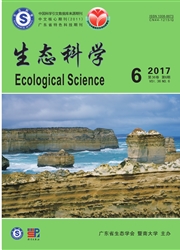

 中文摘要:
中文摘要:
为探究淡水驯化6年后的桐花树幼苗对人工污水的净化效果、耐污能力及最佳去污浓度,采用温室水培试验,分别用无污水、正常浓度、5倍、10倍、15倍、20倍、25倍和30倍浓度人工污水(正常浓度人工污水成分:60 mg·L–1 TOC、51 mg·L–1 TN、5 mg·L–1 TP)对淡水桐花树幼苗持续浇灌60 d后,测定植物生长指标及水质指标。结果表明淡水驯化后的桐花树幼苗能够承受5倍以下浓度污水胁迫,在正常浓度污水中植物生长状况明显优于其他组,株高、基茎、根长月增量最高可达1.27 cm、0.23 mm、0.53 cm,并且延长污水停留时间有助于植物净化水体TOC和TN,改善pH和浊度。经淡水桐花树幼苗去污的最佳污水浓度实验,用淡水桐花树幼苗分别处理1/4倍、1/2倍、正常、2倍、4倍和5倍浓度人工污水,实验结果表明在4倍浓度污水中植物对TOC、TN、TP的净化能力最强,日去除量分别可达69.97 mg、11.51 mg和1.89 mg。因此,在理论上可利用淡水驯化后的桐花树进行人工湿地的构建,提高对淡水环境的净化效果。
 英文摘要:
英文摘要:
To study A.corniculatum's purification effects and resistibility to artificial wastewater and to explore a concentration with highest purifying effect, the hydroponic test was taken in the greenhouse, and the plants were treated with different concentrations of artificial wastewater(none, normal, 5, 10, 15, 20, 25 and 30 times, composition of normal artificial wastewater is: 60 mg·L–1 TOC, 51 mg·L–1 TN, 5 mg·L–1 TP) for 60 days, then the indicators of plants' growth and water quality were determined. The results showed that freshwater adapted A.corniculatum seedlings can survive under five times concentration of artificial wastewater, and plants in normal artificial wastewater grow significantly better than other groups, and the monthly increments of height, stem diameter and root length can be up to 1.27 cm, 0.23 mm, 0.53 cm. Furthermore, extending the hydraulic retention time of artificial wastewater was a beneficial way for purifying TOC and TN, also a favorable way for improving turbidity and pH. To further explore the concentration with highest purifying effect, A.corniculatum seedlings were used to treat 1/4, 1/2, normal, 2, 4 and 5 times concentrations of artificial wastewater. According to this research, under the W4 treatment, the daily removal quantities of TOC, TN and TP were the highest, up to 69.97 mg, 11.51 mg and 1.89 mg. Hence, theoretically, freshwater adapted A.corniculatum can be used in artificial wetlands construction for enhancing the purification effects.
 同期刊论文项目
同期刊论文项目
 同项目期刊论文
同项目期刊论文
 期刊信息
期刊信息
